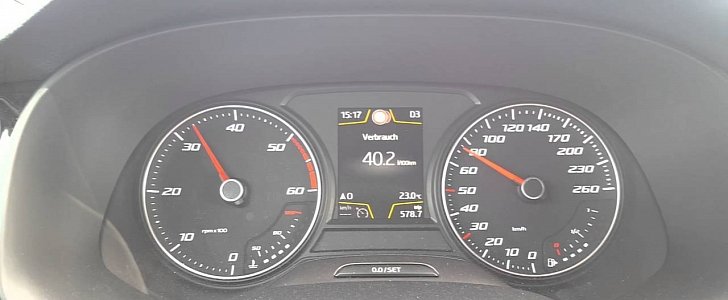For all the "competition" that's suppose happen in the compact utility segment, there aren't that many models that go fast. You can have the GLA-Class if you are rich and don't care about space, or a MINI Countryman. But the family-oriented models are all kind of slow to 62.
Most models use automatic gearboxes and those sold in Europe also rely on diesel engines, who have begun a downsizing trend. For example, the post-facelift Honda CR-V has a 1.6-liter with 160 hp and will reach 62 mph in 9.6 seconds. The Mazda CX-5 may be fun to drive, but it too suffers in acceleration tests.
Volkswagen rarely uses automatic gearboxes, so the Tiguan is a little bit more athletic. However, it's expensive and heavier than SEAT Ateca. Which brings us to the subject of the day: an acceleration test with the first SUV in the history of the Spanish automaker.
As we've mentioned before, the Ateca is not based on the same version of the MQB platform as the Tiguan, and it's also much shorter. The steering and suspension are also engineered to deliver fun in larger quantities.
Even though the Ateca has entered production in week 15 of 2015, the launch is still a few days away. As such, we have only been able to find one acceleration test.
It features a configuration very few buyers will go for, which is a real shame. AWD is combined with a 7-speed DSG gearbox and a 190 horsepower 2.0 TDI engine. Most folks will go for the 1.6 TDI or the 1.4 TSI, and we can't blame them, but with this powerful diesel, the SUV is about as fast as the first Leon Cupra, reaching 62 mph in under 8 seconds.
As some of you may notice, the gearbox isn't even in Sport mode, but on diesel engines, this tends not to be a big issue, as changing gears late is not beneficial. While the SEAT SUV starts at under 20,000 in most European countries, this configuration is about 50% more. Still, it's cheaper than the equivalent Volkswagen.
Volkswagen rarely uses automatic gearboxes, so the Tiguan is a little bit more athletic. However, it's expensive and heavier than SEAT Ateca. Which brings us to the subject of the day: an acceleration test with the first SUV in the history of the Spanish automaker.
As we've mentioned before, the Ateca is not based on the same version of the MQB platform as the Tiguan, and it's also much shorter. The steering and suspension are also engineered to deliver fun in larger quantities.
Even though the Ateca has entered production in week 15 of 2015, the launch is still a few days away. As such, we have only been able to find one acceleration test.
It features a configuration very few buyers will go for, which is a real shame. AWD is combined with a 7-speed DSG gearbox and a 190 horsepower 2.0 TDI engine. Most folks will go for the 1.6 TDI or the 1.4 TSI, and we can't blame them, but with this powerful diesel, the SUV is about as fast as the first Leon Cupra, reaching 62 mph in under 8 seconds.
As some of you may notice, the gearbox isn't even in Sport mode, but on diesel engines, this tends not to be a big issue, as changing gears late is not beneficial. While the SEAT SUV starts at under 20,000 in most European countries, this configuration is about 50% more. Still, it's cheaper than the equivalent Volkswagen.


